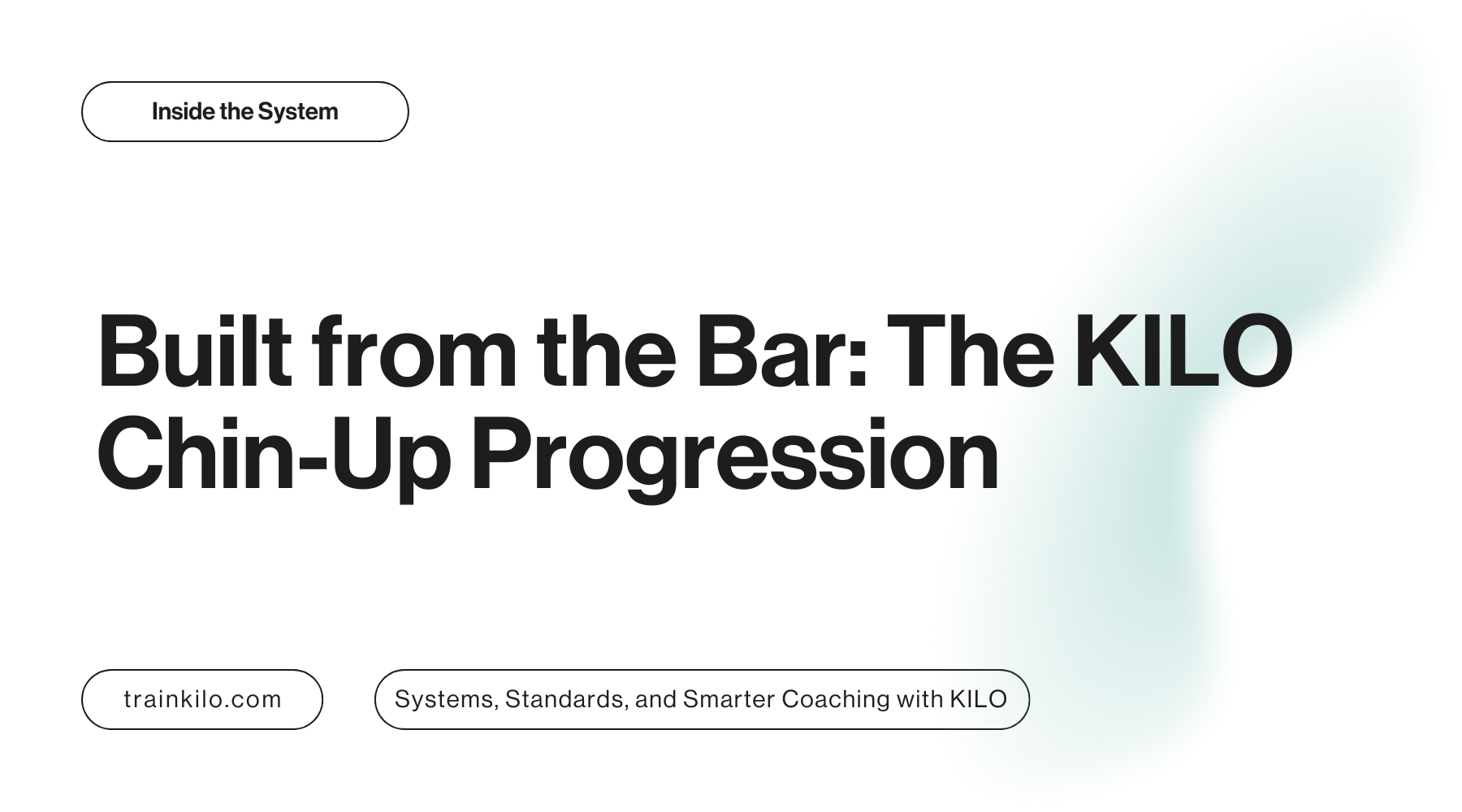Few exercises carry as much respect among strength coaches as the chin-up. It is a raw demonstration of relative strength, the measure of how much force an athlete can generate against their own bodyweight. At KILO, we view the chin-up as one of our PRIMEIGHT™ lifts, the upper-body pulling counterpart to the squat, deadlift, and press. For this reason, our system treats the chin-up not as an assistance movement but as a primary exercise that requires a structured progression model.
In this article, we will outline the three-phase KILO Chin-Up Progression for beginners who cannot yet complete a single strict repetition. We will explain how the progression integrates into the training week, how it is placed in the session structure, and how to determine readiness to advance from one phase to the next.
Why the Chin-Up Matters
The chin-up is more than a back and biceps exercise. From a structural standpoint, it reinforces shoulder health by developing the scapular retractors and depressors. From a performance standpoint, it contributes to pressing strength by balancing the upper-body push-to-pull ratio. From a coaching standpoint, it is one of the simplest and most honest tests of relative strength.
We emphasize that the chin-up belongs in the same conversation as the bench press or squat. When programmed with intention, it can serve as a cornerstone for tracking progress across both hypertrophy and strength phases.
The Structure of Progression
Not every trainee is immediately ready to begin this progression. Overweight individuals or those with very poor general strength levels may first need to focus on basic strength preparation work, such as building a foundation with pulldowns, and in some cases prioritizing fat loss before attempting the chin-up progression. Establishing this baseline ensures that when the progression begins, the lifter has the minimum capacity required to succeed.
Most beginners are unable to perform a single chin-up with proper technique. Instead of treating this as a barrier, the KILO system uses a structured three-phase progression that builds the specific strength needed for mastery. Each phase typically lasts six weeks, which means that most trainees will require a full block at each stage before moving on. By week 13, the average trainee will achieve their first strict chin-up. From that point, the coach assists concentric actions until the lifter can complete 6 consecutive unassisted reps, establishing the foundation for regular bodyweight chin-up training.
One essential element for success is frequency. The chin-up progression must be performed twice per week. This ensures the training volume is high enough to drive a consistent strength response.
Another essential element is placement. In the session, the chin-up progression is always performed in the A-series, specifically as the A2 exercise, following a pressing movement. The sequence is structured as follows:
-
A1. Press → rest 90–120 seconds
-
A2. Chin-Up (Medium Neutral Grip) → rest 10 seconds
-
A3. Pulldown (Medium Neutral Grip) → rest 90–120 seconds, then return to the press
This structure ensures high-quality chin-up efforts, followed immediately by a reinforcing pulldown pattern at a strict and controlled tempo.
Phase 1: Eccentric Foundation
Phase 1 begins with eccentric-only chin-ups using a 10-second lowering. Trainees perform as many controlled eccentric reps as possible, then transition directly into 8-10 repetitions on a neutral-grip pulldown at a 4-0-1-0 tempo. This pairing builds time under tension in the exact chin-up pattern while accumulating pulling volume through the pulldown.
The key advancement rule is simple: remain in Phase 1 until a total of 15 eccentric reps are completed across all sets in a single session. For most beginners, this requires the full six weeks of a training block before progressing to the next phase.
Phase 2: Isometric Control
Phase 2 raises the demand by introducing 3-pause eccentrics. Each full eccentric repetition lasts approximately 30 seconds, with 10-second pauses taken at strategic points in the range of motion (top quarter, mid-point and bottom quarter). This teaches positional control and reinforces scapular stability where lifters are typically weakest. Immediately after the paused eccentric work, trainees complete 6–8 repetitions of the same neutral-grip pulldown on a 4-0-1-0 tempo.
The progression rule is to remain in Phase 2 until the lifter completes a total of 12 pause-eccentric reps across all sets in a single session. This typically requires another full six-week block.
Phase 3: Assisted Repetitions
In order to move onto the third progression, the trainee needs to be able to complete at least one chin-up repetition on their own. At this point, phase 3 introduces full-range chin-up practice with assistance. Using ankle support from a partner, the trainee performs concentric and eccentric actions at a 4-0-1-0 tempo. The assistance provides just enough help to ensure a strict range of motion without compensations.
The target is clear: stay in Phase 3 until the lifter can complete 6 strict unassisted chin-ups per set. At this point, the foundation is established, and the trainee is ready to begin programming chin-ups as a true Primeight™ exercise within the standard rep schemes of the KILO system.
Coaching Takeaways
The chin-up progression for beginners is not about novelty; it is about sequence, structure, and sufficient frequency. By training twice per week, pairing chin-ups with pulldowns in the A-series, and respecting the advancement rules of each phase, coaches create predictable progress for athletes who once struggled to lift their bodyweight even once.
The KILO Chin-Up Progression is straightforward but powerful: eccentrics build the base, isometric pauses develop control, and assisted reps bridge the gap to mastery. With patience and structure, coaches can take any beginner from zero to their first strict chin-up, then beyond into the full KILO system of strength development.


Share:
Two-a-Day Training: Structuring Double Sessions for Smarter Results